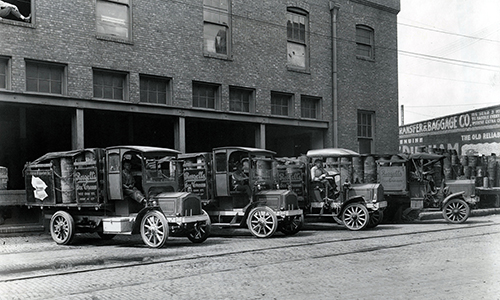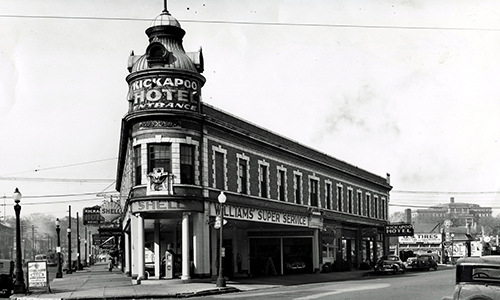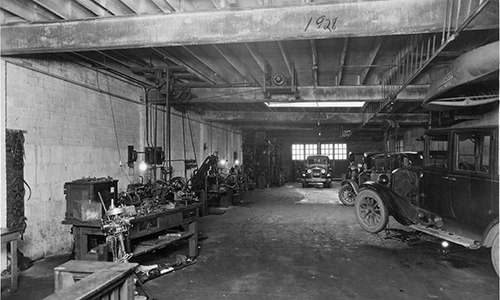The Warehouse District’s historic designation opens up new tax credits for building owners to preserve Peoria’s past.
The air is frigid inside the warehouse at 733 SW Washington Street. Downstairs, building owner Larry Winkler points to where Roszell’s Dairy parked its milk trucks starting in 1926, when the building was constructed. He opens the door to a large freight elevator shaft, leading to a compressor room above: evidence of the building’s most recent occupant, Winkler Meats. In a nearby office, a framed grocery store flyer offers up 10-cent heads of lettuce and 39-cent pounds of chuck roast at Winklers on 625 N. Perry, a reminder of the company’s origins. Over time, that corner store evolved into the distribution company, Winkler Meats, which Winkler sold in 1998. The company continued operating out of this building until last year, when it departed in an effort to reorganize.
The building’s evolution is written in these walls—a lustrous, exposed brick just right for the industrial-style apartments Winkler is constructing on the second floor. Light pours in through the southeast-facing windows that he’s replacing with historically appropriate ones, as mandated by the Illinois Historic Preservation Agency (IHPA). This replacement, among other to-dos, is necessary to receive the historic preservation tax credits for which he is now eligible. The Warehouse District’s recent historic designation didn’t just motivate Winkler to take on this renovation, it entirely enabled him. “I’m not sure any of this would be possible without the tax credits,” he explains.

Preserving Peoria’s Industrial Past
The IHPA’s approval of Peoria’s River Edge Redevelopment Zone last September marked the final step in the City of Peoria’s application to list the Warehouse District on the National Register of Historic Places, a process that took over a year to complete. One of just five designated River Edge Development Zones in the state, the Warehouse District joins two other historic districts and 23 individual sites in Peoria already listed on the National Register, including City Hall, the Madison Theatre, the Pere Marquette and the Kickapoo Building.
Among the benefits of this designation: building owners can forego the hassle of individually listing their buildings—saving time and money—in seeking the pair of associated financial incentives. The first, the Federal Historic Preservation Tax Credit Program, provides federal income-tax incentives for the rehabilitation of historic, income-producing properties. The IHPA’s Preservation Services division administers this 20-percent tax credit for “the substantial rehabilitation of commercial, agricultural, industrial or rental residential buildings that are certified as historic.” The second, the Illinois Historic Preservation Tax Credit Program, provides a state income-tax credit equal to 25 percent.
“The [Illinois] tax credit now in place is kind of a pilot project of its own… the subject of legislation in 2011 that was created as an incentive within ‘River Edge Redevelopment Zones,’” explains Chris Setti, assistant city manager. This credit can only be used on qualified expenditures by owners of certified historic structures located within these specified zones—in Aurora, East St. Louis, Elgin, Rockford and now, Peoria. Together, both federal and state incentives amount to a reimbursement of up to 45 percent—an enticing incentive for projects in a district that’s stood still for years.
Making the List
As the nation’s official list of historic sites worthy of preservation, the National Register of Historic Places supports public and private efforts to identify, evaluate and protect the country’s historic resources. Made possible through the National Historic Preservation Act of 1966 and administered by the National Park Service, it includes more than 90,000 listings—but obtaining the designation is no easy feat.
To be listed, sites must meet the National Register Criteria for Evaluation, which involves a combination of the properties’ age, integrity and significance. For instance, an evaluation might consider whether the property is old enough to be considered historic—generally at least 50 years—and whether the site has stayed true to its original form. In addition, the building’s significance is contemplated—whether it was associated with important events, activities or developments in the past, or historic figures passing through.
“[The Warehouse District] was listed because of its age—they’re older buildings,” explains Michael Freilinger, president of the Downtown Development Corporation of Peoria (DDC). “They also look for the significance of the architecture. What they were able to do is look at the whole district and say, as a district, this… has significance.”
After nominations are submitted to the state’s historic preservation office by individuals or groups seeking status, a review process begins with a public comment period. During this time—a minimum of 90 days—if a building owner objects, the property cannot be listed. Nominations are then reviewed by the state office and the National Register Review Board, and accepted or denied.
It took Bob Howard, owner representative of the Kickapoo Building at Main and Hamilton, a 59-page application and more than a year to get that building listed.
Navigating the Process
“It was 36 rooms over a saloon; now it’s six rooms over an internet café,” Howard says, pointing out the floor-to-ceiling door openings, trims and transoms that were retained and repaired in the building’s V-shaped corridor. Howard’s recent rehabilitation of the space above Thirty-Thirty Coffee Co. transformed the floor into three single-bedroom and three two-bedroom apartments—ideally located, he says, for medical students or Cat employees.
Howard traverses the unique, curved wall of windows in one of the $1,500-per-month, two-bedroom, two-bathroom apartments. “Look around you. See all the hospitals? You’re right in the cusp of what’s downtown,” he says. “We’re in a really strategic location.” But it’s the building’s history that adds allure to the units.
The only three-faced, triangular flatiron building left in Peoria, the Kickapoo Building began as a tied-house—a saloon with an exclusive brewery contract—when Augie Busch arrived in Peoria by train in 1910. An Anheuser-Busch logo remains on its façade, a reminder of the fierce competition among breweries in the days before the system came to a sudden halt with the onset of Prohibition in 1920. Since then, it has served a number of purposes: as a Shell Oil station, hotel, bartender school and music studio. When entrepreneur Jim Jumer purchased the building in the 1970s, he rented it out for a variety of uses. Now in the hands of his children, the historic property is taking on its first use as apartments, opening this month.
“[Jim] believed in the downtown… that’s part of the reason the family wanted to go ahead with this,” Howard explains. “It meant everything to get the tax credits,” he adds, but it’s also added time and costs. “You don’t know what you’re going to run into in these massive walls.” The discovery of joists running in different directions, for instance, led to the kitchens’ redesign, and finding a “historically accurate” fire escape added additional expense. “They just don’t build them anymore!” he exclaims. “We had to find some pictures [the IHPA] would agree to and have it specifically fabricated.”
Freilinger understands that participation in the tax credit programs adds expense to these projects. But back in the Warehouse District, where up to 45 percent of project costs can be refunded, he adds: “In most cases, people believe the additional cost is outweighed by the tax credits.”
The DDC has assisted property owners and developers in navigating the credit process by sponsoring workshops and coordinating site visits by the IHPA to perform initial walk-throughs. Unfortunately, the process isn’t entirely straightforward, notes Winkler, who attended the workshops. For one, smaller developers are unable to take full advantage of the tax credits without the assistance of investors who can utilize them. To address this issue, the DDC is working to bring investors to the table who can utilize the credits, but timing is critical. With the State Historic Tax Credit slated to end on December 31, 2016, the DDC and City of Peoria are working on options to extend the program, as continued renovation and historic preservation are crucial to the city’s Heart of Peoria Plan, which envisions the Warehouse District as a vital part of Peoria’s downtown.
If You Build It, They Will Come
Last fall, local entrepreneur Pat Sullivan unveiled his latest project—the renovation of the Sealtest building into a mixed-use living and work space, slated for completion this spring. The renovation of this building in particular, he suggests, is crucial to downtown Peoria’s overall development.

“This building at State and Washington here is what we call the ‘four corners.’” With the post office down the block and Washington Street’s steady flow of traffic, it may be the busiest intersection in the Warehouse District, he says. “So, these four corners are very important to have revamped and brought back to their originality.”
In the late 1800s, the Sealtest building was home to an ice cream factory, Sullivan explains, also owned and operated by the Roszell family, whose operations stretched “north” of Peoria, where they owned farmland near today’s intersection at Lake and Knoxville. Access to the historic tax credits for Sullivan’s renovations meant preserving what remains of the building’s early history. The brick walls, vaulted ceilings and various platforms—which once held huge vats of ice cream—are among the list of features required for preservation, he notes.
It’s an impressive building, to be sure. Sullivan points out where restaurateur Travis Mohlenbrink’s latest venture, Thyme, will have its al fresca dining—with tables open to Washington Street. An adjoining door will lead to the restaurant’s banquet facility, while another room slated for office space holds a narrow staircase leading to the second floor. This, too, is a potential workplace, he explains, motioning toward the high, expansive ceilings and daylight pouring in through a huge wall of windows and two skylights. Half of the condos are already spoken for, and he has no doubt the others will be taken soon.
Sullivan advocates for downtown living—he’s been a resident of downtown Peoria since the late ‘90s. What’s needed now, he explains, are more living components. “There’s a lot to be done,” he says. “So we’re out trying to get developers interested in some of the other buildings. We help as much as we can… because it raises the value of the whole area, and it helps the city to get other businesses into the area.”
As more people move downtown, the stores will follow, he notes with confidence. “We’re looking for people who want to do the mom-and-pop shops,” he adds. “The living component—the area can sustain it, and the city wants it.”
The Millennial Appeal
“You’ll have to use your imagination,” Winkler laughs, “but this will be a studio.” He enters a model studio—a 475-square-foot apartment with a ladder leading to additional loft space. An enormous window dominates the room, anchored temporarily by file cabinets: one marks the spot for a refrigerator in the kitchen; the other, a small utility closet in the bathroom. The apartment will be one of up to 27 that Winkler intends for the building.
It’s not too hard to imagine. The original maple floors, exposed brick walls and vaulted ceilings have that coveted industrial feel—what Winkler calls a “generational preference.” And he’s right: the industrial style may be just the ticket to draw in millennials anxious for downtown urban living. According to the Heart of Peoria Plan, the Warehouse District is important not only for its preservation of Peoria’s industrial past, but because its adaptive re-use will attract more young professionals—critical to Peoria’s cultural and economic future.
Winkler’s model apartment emanates the style of luxury lofts in Chicago’s Fulton River District or the Meatpacking District of New York, and in those cities, Winkler might be sitting on a gold mine. But here in Peoria’s Warehouse District, he’s anxious for the shops to come back, hoping that he and other developers are not simply creating a bedroom community for retail centers across the river.
“When we had that little store on Perry Street, there was a driver’s license place next door, a dry cleaning place next to that, [and] an apartment with a big laundromat for the public. Across the street was… a liquor store and a barber shop. That was all in one block.” In fact, according to Winkler, his store’s breadman had 50 stops just between Main Street and the McClugage Bridge. But as the big chains moved in, those businesses closed down, and for years, the Warehouse District remained quiet.
What the People Want
In the three years Jeff Embry has run Studio 825 on Southwest Adams, he’s witnessed great change. Before, he says, many people wouldn’t dare to venture into the area after dark. But with the recent pedestrian-friendly changes—new lighting, wider sidewalks, planters and more—people are flooding into the neighborhood for First Fridays’ art walks and the wood-fired pizzas at Sugar.
Embry’s studio—home to more than a dozen local artists—is a popular stop on the First Fridays circuit, but he has bigger plans for the building. He hopes to convert the 12,000 square feet of space above the studios, abandoned for a quarter of a century, into a large-scale performing arts center. The tax credits will be essential, he says, as the project will be a “massive undertaking.”
The building at 825 SW Adams is actually the third at this location, Embry notes. In 1911, Sy Grawey started an automobile parts business there, with expansions added in 1915; the current structure was erected six years later. “AutoZone didn’t exist in 1921, so if you damaged your vehicle and needed a part, you could wait an incredibly long time because all the parts back then were handmade,” Embry explains. “[Grawey] solved that problem.”
Each part of the building served a different purpose in the process of dismantling engines, transmissions, bodies, electric systems and more. Later, following World War II, a 32,000-square-foot bowling alley was built on the second floor, and the site became known as Peoria Auto Parts Bowling. After it closed, one section of the second floor was divided into a dinner theater and dance club; the other, a 12,000-square-foot archery range, remained open through the ‘80s. When Embry moved in, little evidence of this history remained, save a few ancient auto parts, but old photographs verify that his own woodworking shop was once stacked floor to ceiling with leaf springs and car front suspensions.
Before receiving the tax credits, Embry and the building owner will host a walk-through with the IHPA, but he already intends to leave everything in the building “as natural as possible,” and he has the team to do it. Studio 825’s slew of artists will make the hardwood floor, metalwork and glass restoration projects easy, he says, “so people can really enjoy the original aesthetic of the building.”
This project, among others, he suggests, will help rejuvenate the street and bring people back downtown. It’s a national desire, Freilinger adds, and Peoria’s in tune with the demand. “What we’re seeing across the country is a real interest by people to live in historic buildings and an appreciation for the architecture of the past. So, having a historic building and rehabbing it for a modern purpose or reuse tends to be a good investment.” With the tax credits, he says, “developers are finding it’s worth their while.”
“The millennials like to live downtown in an urban environment,” adds Howard. “They prefer to rent versus own. They don’t necessarily have cars, so they want to be downtown where they can get around.”
Back in Winkler’s building, he says the space should be exactly what people want. “It’s the high ceilings, the brick, the openness, industrial look, cool lighting…” At the end of our tour, Winkler pokes his head into the front office to say hello to his tenant, the Illinois Federation of Teachers, which has been located here for years. “They wanted to be here,” he says, suggesting that with the addition of new living options, others will want to be here as well. “I don’t know—maybe there’s some magic in the Warehouse District,” he says with a grin. iBi


